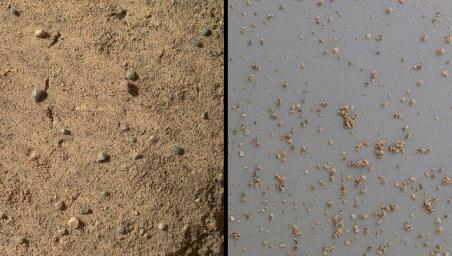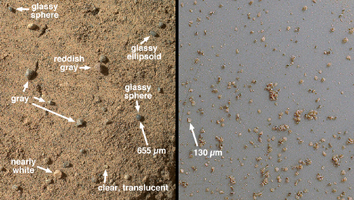
|
Windblown Sand from the ‘Rocknest’ Drift
- Click the image above for a larger view
- Full-Res JPEG (1248 x 706) (255.2 kB)
- Full-Res TIFF (1248 x 706) (2.6 MB)
Caption:

Annotated Image
Click on the image for larger version
The Mars Hand Lens Imager (MAHLI) on NASA's Mars rover Curiosity acquired close-up views of sands in the "Rocknest" wind drift to document the nature of the material that the rover scooped, sieved and delivered to the Chemistry and Mineralogy Experiment (CheMin) and the Sample Analysis at Mars (SAM) in October and November 2012.
The picture on the left, acquired on the 58th Martian day or sol of the mission (Oct. 4, 2012), covers an area of about 0.75 by 0.87 inches (1.9 by 2.2 centimeters) and shows some of the variety of coarse sand grains observed on a portion of the Rocknest wind drift that was flattened by the left front rover wheel. Though Mars is thought of as the Red Planet, the sands of Mars are not necessarily red. This one small area shows clear, translucent grains, gray sand and white sand, in addition to two blue-gray glassy spheres and a glassy ellipsoid. The spherical and ellipsoidal grains were likely formed from molten droplets that cooled above the Martian surface to form glass, either during an explosive volcanic eruption or an impact cratering event. Similar grains are found in association with impacts on Earth and explosive volcanoes on the moon. The larger glassy sphere is 0.026 inches (655 micrometers) in diameter.
The picture on the right, acquired on Sol 73 (Oct. 20, 2012), shows a magnified view of the fraction of smaller sand grains examined by Curiosity. These are grains that were collected in the rover's third scoop. They were passed through a sieving system in the Collection and Handling for In-Situ Martian Rock Analysis (CHIMRA) tool on the rover's turret; only grains smaller than 0.006 inches (150 micrometers) passed through the sieves. In this image, the sieved grains are viewed on Curiosity's approximately 2.9-inch-diameter (about 7.5-centimeter-diameter) observation tray; the image shown here covers a much smaller part of the tray, just 0.26 by 0.30 inches (6.5 by 7.6 millimeters). Many of these fine sand grains are angular pieces of crystalline minerals, ideally suited for analysis by the Chemistry and Mineralogy Experiment (CheMin).
Background Info:
JPL manages the Mars Science Laboratory/Curiosity for NASA's Science Mission Directorate in Washington. The rover was designed, developed and assembled at JPL, a division of the California Institute of Technology in Pasadena.
For more about NASA's Curiosity mission, visit: http://www.jpl.nasa.gov/msl , http://www.nasa.gov/mars , and http://mars.jpl.nasa.gov/msl .
Cataloging Keywords:
| Name | Value | Additional Values |
|---|---|---|
| Target | Mars | |
| System | ||
| Target Type | Planet | |
| Mission | Mars Science Laboratory (MSL) | |
| Instrument Host | Curiosity Rover | |
| Host Type | Rover | |
| Instrument | Mars Hand Lens Imager (MAHLI) | |
| Detector | ||
| Extra Keywords | Color, Crater, Impact, Volcano | |
| Acquisition Date | ||
| Release Date | 2012-12-03 | |
| Date in Caption | 2012-10-04 | 2012-10-20 |
| Image Credit | NASA/JPL-Caltech/MSSS | |
| Source | photojournal.jpl.nasa.gov/catalog/PIA16570 | |
| Identifier | PIA16570 | |
